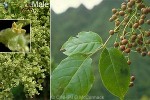Cook Islands Biodiversity Database
Species Page
Bischofia javanica
KokaBischofia
Multimedia & Additional Resources
| Type | Description | Download |
| Leaf and fruit; Left male flowers | 54KB |
General Information
Cook Islands Distribution
| Southern Group: Present Makatea: - | ||||||||
RR |
MG |
AT |
MK |
MT |
AK |
PL |
TK |
MN |
+++ |
- |
- |
- |
- |
- |
- |
- |
- |
| Northern Group: - | |||||
TN |
MH |
RK |
PK |
NS |
SW |
- |
- |
- |
- |
- |
- |
Scientific Taxonomy
Bischofia javanica Blume
SYNONYMS: Bischoffia javanica [misspelt]; Allophyllus vitiensis [sensu GW]
TAXONOMY: PLANTAE; ANTHOPHYTA (=Angiospermae); MAGNOLIOPSIDA (=Dicotyledones); ROSIDAE; Euphorbiales; EUPHORBIACEAE. COMMENT: Named after G.W.Bischoff, with an original latinisation as Bischofia, not Bischoffia. This monotypic genus is here kept in EUPHORBIACEAE, while others put it in its own family BISCHOFIACEAE and place this in the order Sapindales.
More Information
SIGNIFICANCE NOTES -. Comment: NBSAP - Puaikura (3 of 3 wild plants)
POSITIVE SIGNIFICANCE: Medicine, Material (Dye). Comments: Used in Samoa and Tonga to make a dye for tapa cloth, this use is not recorded in the Cook Islands. Seeds are used as ammunition in peashooters. The fruits are used medicinally (Whistler 1990). Makes hard and durable posts. Timber similar to Mahogany - red and easily worked, though vulnerable to attack by borer.
GENERAL NOTE: The eastern limit of this species as an indigenous tree is difficult to determine, but presumably at least to Fiji, Samoa and Tonga; Cook Islands and Societies indigenous or Polynesian introduction; Hawaii a recent introduction (AC. Smith, Flora of Fiji).
Gives hard and durable posts; and in Tonga and Samoa the bark is used to make a red-brown dye commonly used on tapa [AC Smith].
Vouchers & References
Vouchers:
None Recorded.
References:
p.601 Wagner et al.- Flowering Plants of Hawaii
p.504 Neal - In Gardens of Hawaii
p.165 Hortus 3rd
p.153 Royal Hort. Soc. Index of Garden Plants
p.407 Tropica
p.2/495 A.C.Smith - Flora Vitiensis Nova
p.295 I Cheeseman - Flora of Rarotonga
p.69 Wilder - Flora of Rarotonga
p.370c Whistler - Ethnobotany of the Cook Islands
p.108 McCormack/Kunzle - Rarotonga's Mountain Tracks and Plants
Data Update History (information):
zTX, zB02, zM03a, zD02
Web Resources
Citation Information
McCormack, Gerald (2007) Cook Islands Biodiversity Database, Version 2007.2. Cook Islands Natural Heritage Trust, Rarotonga. Online at http://cookislands.bishopmuseum.org. ![]()
Please refer to our use policy.

